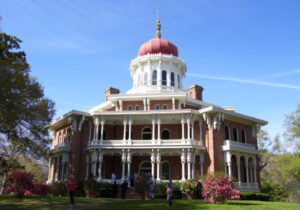Headlines
HottyToddy Hometown: Natchez, Mississippi

History of Natchez
Natchez, the birthplace of Mississippi, is known internationally as a quaint, Southern town with a rich culture and heritage shaped by people of African, French, British and Spanish descent. It’s first inhabitants, however, were the Natchez Indians and it was French explorers who first came to the area and made it their home in peace with the tribe.
Shortly after French settlers joined the Natchez Indians on a bluff overlooking the Mississippi River, they brought people from western Africa as slaves to provide labor for development. These members of the Bambara tribe — whose name means “those who accept no master” — were the first Africans in what would become the State of Mississippi. Known for their abilities to cultivate the earth, the Bambarans contributed greatly to the economic growth of the region and the nation.
As the settlement grew, French, English and Spanish residents began constructing homes and buildings in the styles with which they were familiar, leaving several architectural influences and creating the unique backdrop to the city with which our residents and visitors enjoy today.
Today, the legacy of these original settlers lives on in the historical sites that enrich Natchez and its surroundings — including the churches of the state’s oldest Black-Baptist and Catholic congregations — and in the lives of the area’s vibrant community.
Visitors to Natchez can explore the community’s cultural, economic and political growth through the Natchez Visitor Center, the Natchez National Historical Park, the museum of the Natchez Association for the Preservation of Afro-American History and Culture and Natchez Pilgrimage Tours. These fascinating learning opportunities are complemented by celebrations and events throughout the year, including Fall and Spring Pilgrimage, The Natchez Literary and Cinema Celebration, Black History Month and many more.
Native American History in Natchez
The Natchez are a Native American people who originally lived in the Natchez Bluffs area, near the present-day city of Natchez, Mississippi. They spoke a language isolate that has no known close relatives, although it may be very distantly related to the Muskogean languages of the Creek Confederacy.
The Natchez are noted for being the only Mississippian culture with complex chiefdom characteristics to have survived long into the period after the European colonization of America began. Others had generally declined a century or two before European encounter. The Natchez are also noted for having had an unusual social system of nobility classes and exogamous marriage practices. It was a strongly matrilineal society with descent reckoned along female lines, and the leadership passed from the chief, named “Great Sun”, to his sister’s son which ensured the chiefdom stay within one clan.Ethnologists have not reached consensus on how the Natchez social system originally functioned, and the topic is somewhat controversial.
Around 1730, after several wars with the French, the Natchez were defeated and dispersed. Most survivors were sold by the French into slavery in the West Indies; others took refuge with other tribes, such as the Muskogean Chickasaw and Creek, and the Iroquoian-speaking Cherokee. Today, most Natchez families and communities are found in Oklahoma, where the Natchez Nation is a treaty tribe. Members are also enrolled in the federally recognized Cherokee and Muscogee (Creek) nations. Two Natchez communities are recognized by the state of South Carolina.
French History in Natchez
The French explored the lower Mississippi River in the late 17th century. Initial French-Natchez encounters were mixed. In 1682 René-Robert Cavelier, Sieur de La Salle led an expedition down the Mississippi River. The Natchez received the party well, but when the French returned upriver, they were met by a hostile force of about 1,500 Natchez warriors and hurried away. At the time of the next French visit in the 1690s, the Natchez were welcoming and friendly. When Iberville visited the Natchez in 1700, he was given a three-day-long calumet peace ceremony and feast.
French Catholic missionaries from Canada began to settle among the Natchez in 1698. Early French Louisiana was governed by Pierre Le Moyne d’Iberville and his brother Jean-Baptiste Le Moyne, Sieur de Bienville, among others. Both brothers played a major role in French-Natchez relations.
In the 1710s and 1720s, war broke out four times between the French and the Natchez. The French called these the First Natchez War (1716), the Second Natchez War (1722), the Third Natchez War (1723), and the Natchez Rebellion of 1729.
The last of these wars was the largest, in which the Natchez destroyed the French settlements in their territory. In retaliation, the French eventually killed or deported most of the Natchez people. Overshadowing the first three in scale and importance, the 1729 rebellion is sometimes simply called the Natchez War. In all but the last war, peace was regained largely due to the efforts of Tattooed Serpent of the Grand Village of the Natchez.
After the 1716 Natchez War, the French built Fort Rosalie near the Grand Village of the Natchez. The present-day city of Natchez, Mississippi had its origin in the 1716 establishment of Fort Rosalie.
African American History in Natchez
Enslaved people from Western Africa were first brought to the Natchez area by the French in 1719. By 1723, the number of inhabitants at the French settlement in Natchez had risen to 303, with over a third of them being of African origin. The English and Spanish, controlled the Natchez area following the French, continuing the expansion of slavery in the area well into the 1700’s. The Forks of the Road in Natchez was the site of the second largest slave markets in the South, behind only the Algiers market outside of New Orleans.
Natchez also had the largest population of free people of color in the state of Mississippi. Some free people of color were born into slavery and then set free, and some were born to freed slaves. Free people of color in Natchez worked a variety of jobs, from barbers and dressmakers to cooks and nurses. Some, such as the well known William Johnson, became slave owners themselves, living comfortably, and educating their children. However, they could not vote, hold office, serve on juries or testify against whites. They also could not walk around without written proof of freedom or operate taverns or grocery stores.
When the Civil War broke out, the following years would be an intense period for African Americans in the Natchez area. Many of them seized the opportunity for self emancipation, and fled to Natchez during the Union occupation of the town after the fall of Vicksburg in July 1863. Natchez became a large refugee camp for former slaves. Freedmen were hired to work on fortifications or abandoned plantations. They were also recruited into the U.S. Army. By 1864, four regiments of black soldiers were garrisoned in Natchez with over 3,000 black Union soldiers throughout the war.
During the beginning of the Reconstruction period, African Americans had a brief period of political power and civil rights in Natchez, and throughout the South. Natchez’ very own Hiram Revels became the first African American to serve in the United States Senate. Black men opened businesses and women taught in the first public schools for African American children. New churches sprang up across town.
In Natchez, African Americans were elected to the U.S. Congress, Adams County School Board, Board of Alderman, as well as many other elected county positions. Natchez was also the only town in Mississippi to elect an African American mayor during Reconstruction.
Unfortunately, strides in equality of civil rights and political power were short-lived. Through voting fraud, and much intimidation, white resistance began to succeed and by 1890, a new state constitution virtually ended political power for African Americans. “Jim Crow” laws were passed one after another, requiring the separation of blacks and whites in public places. In spite of this, Natchez managed to boast a well educated class of businessmen, professionals, and educators during what was a very difficult era for African Americans across the South.
In 1964, the year President Johnson signed the major Civil Rights Act forcing integration in public places, violence reached its peak. Kidnappings, beatings and bombings were commonplace toward the African American community.
. Local black churches and businesses served as hubs for Civil Rights gatherings and activities, and within a generation, African Americans in Natchez had achieved full voting rights, desegregated schools and public places, and began being elected to public office once again.
The influence of African Americans in Natchez is immeasurable. The words and music of Natchez writers and musicians span the globe. From the blues of “Hound Dog ” Taylor to the acclaimed writings of Richard Wright, the words and songs of Natchez natives have been heard in classrooms and concert halls across the country. Heritage tourist sites and historical markers bring the history and significance of African Americans in Natchez into the experience of visiting Natchez.
British History in Natchez
In 1763, Great Britain obtained possession of the Natchez territory by treaty with France, and the British Union Jack was flung to the breezes from the ramparts of Fort Rosalie. Under British rule, Natchez was a part of the Province of West florida, and the chief outpost of Great Britain on the Mississippi River, Natchez was under British rule during a greater part of the Revoluntionary War and its citizens being for the most part French and Spanish, Natchez took little part in the war for American independence. Her citizenship was increased materially during this period by Loyalists who migrated from the Atlantic sea board, bringing with them their families, their wealth, and their slaves.
Spanish History in Natchez
Great Britain’s rule over Natchez was short. In 1779, an expedition under Don Barnado de Galvez, then Spanish Governor of the Louisiana territory, captured the city and once again Natchez came under yet another flag – the colors of Old Spain. The rule of the Spaniard was a benevolent and peaceful one and under their laws, the territory about Natchez prospered.
Many of the present day homes in and about Natchez were built during the reign of Spain and many are fine types of Spanish architecture – from the slave rooms in the cellars, to the lofty turrets which crowned their roofs. The exquisite iron spiral stairways of the period, the hand wrought iron railings, the broad verandas, the enclosed gardens of Spanish days exist today – a bit of Old Spain in a new World.
The Spanish occupants of Natchez were the engineers behind the layout of the city’s streets and the city was built on a symmetrical grid.
For more about visiting Natchez, things to do, the history and more, visit www.VisitNatchez.org. Information courtesy of VisitNatchez.org also.
















